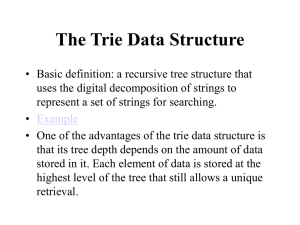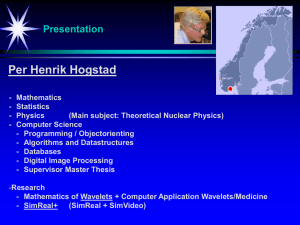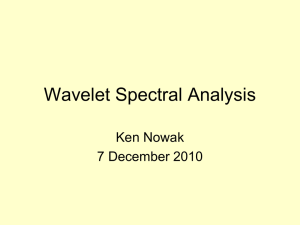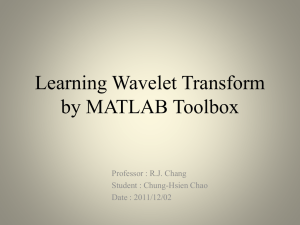slides - Università di Pisa
advertisement
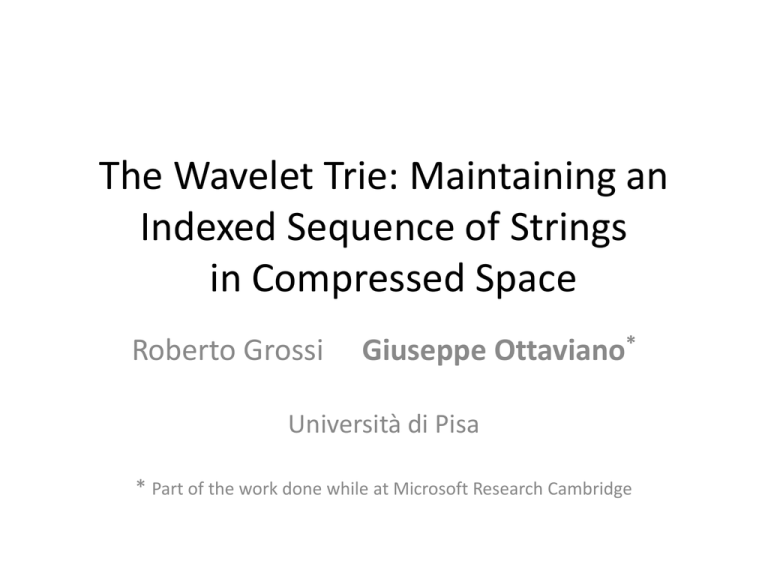
The Wavelet Trie: Maintaining an
Indexed Sequence of Strings
in Compressed Space
Roberto Grossi
Giuseppe Ottaviano*
Università di Pisa
* Part of the work done while at Microsoft Research Cambridge
Disclaimer
THIS HAS NOTHING TO DO
WITH WAVELETS!
Indexed String Sequences
(foo, bar, foobar, foo, bar, bar, foo)
0
1
2
3
4
5
6
• Queries
– Access(i): access the i-th element
• Access(2) = foobar
– Rank(s, pos): count occurrences of s before pos
• Rank(bar, 5) = 2
– Select(s, i): find the i-th occurrence of a s
• Select(foo, 2) = 6
Prefix operations
(foo, bar, foobar, foo, bar, bar, foo)
0
1
2
3
4
5
6
• Queries
– RankPrefix(p, pos): count strings prefixed by p
before pos
• RankPrefix(foo, 5) = 3
– SelectPrefix(p, i): find the i-th string prefixed by p
• SelectPrefix(foo, 2) = 3
Example: storing relations
• Write the columns as string sequences
– Store them separately
– Reduce relational operations to sequence queries
User
Likes URL
0 Leonard battle.net/wow/
0
1 Penny
tmz.com
1
2 Sheldon battle.net/wow/
2
3 Penny
thecheesecakefactory.com
3
What does Sheldon like?
Who likes pages from
domain wikipedia.org?
4 Leonard wikipedia.org/Star_Trek
4
5 Sheldon wikipedia.org/String_theory
5
6 Sheldon marvel.com
6
Other operations: range
counting, …
Dynamic sequences
We want to support the following operations:
• Insert(s, pos): insert the string s immediately
before position pos
• Append(s): append the string s at end of the
sequence (special case of Insert)
• Delete(pos): delete the string at position pos
If data structure only supports Append, we call it
append-only, otherwise dynamic (or fully dynamic)
Requirements
• Store the sequence in as little space as
possible
– Close to the information-theoretic lower bound
• But still be able to support all the described
operations (query and update) efficiently
– Aim for worst-case polylog operations
Some notation
(foo, bar, foobar, foo, bar, bar, foo)
0
1
2
3
4
5
6
• Sequence S, |S| = n
– In the example n = 7
• String set Sset is unordered set of distinct strings
appearing in S
– In the example, {foo, bar, foobar}, |Sset| = 3
– Also called alphabet
• Sequence symbols can also be integers, characters, …
– As long as they are binarized to strings
Wavelet Trees
• Introduced in 2003 to represent Compressed
Suffix Arrays
• Support Access/Rank/Select on sequences on
a finite alphabet (of integers)
– Reduces to operations on bitvectors by recursively
partitioning the alphabet
• String sequences can be reduced to integer
sequences
Wavelet Trees
• S = (a, b, r, a, c, a, d, a, b, r, a), Sset={a, b, c, d, r}
abracadabra
00101010010
{a, b}
{c, d, r}
abaaaba
0100010
rcdr
1011
{d, r}
a
b
rdr
101
c
d
r
Wavelet Trees
• Space equal to entropy of the sequence
– Plus negligible terms
• Supports Access/Rank/Select in O(log |Sset|)
• Later extended to support Insert/Delete…
– … but tree structure is fixed a priori
– String set Sset is cannot be changed!
– Unrealistic restriction in many database
applications
The Wavelet Trie
• The Wavelet Trie is a Wavelet Tree on
sequences of binary strings (Sset ⊂ {0, 1}*)
• Supports Access/Rank(Prefix)/Select(Prefix)
• Fully dynamic…
• … or append only (with better bounds)
• The string set need not be known in advance
Wavelet Trie: Construction
Sequence of binary strings
Branching bit: β
010111
0100110
0100001
0101010
0100110
010111
010110
Common prefix: α
α: 010
β: 1001011
0
110
001
110
1
11
010
11
10
Wavelet Trie: Construction
α: 010
β: 1001011
010111
0100110
0100001
0101010
0100110
010111
010110
α: ε
β: 101
α: 01
α: 10
α: ε
β: 1011
α: ε
β: 110
α: 10
α: ε
α: ε
Wavelet Trie: Access
α: 010
β: 1001011
0
1
2
3
4
5
6
010111
0100110
0100001
0101010
0100110
010111
010110
α: ε
β: 101
α: 01
Access(5) = 010 1 1 1
Rank is similar
α: 10
α: ε
β: 1011
α: ε
β: 110
α: 10
α: ε
α: ε
Wavelet Trie: Select
α: 010
β: 1001011
0
1
2
3
4
5
6
010111
0100110
0100001
0101010
0100110
010111
010110
α: ε
β: 101
α: 01
α: 10
Select(0100110, 1) = 4
α: ε
β: 1011
α: ε
β: 110
α: 10
α: ε
α: ε
Wavelet Trie: Append
α: 010
β: 1001011 0
010111
0100110
0100001
0101010
0100110
010111
010110
010010
α: ε
β: 101 1
α:10
ε
α:
β: 110
α: 01
Insert/Delete are
similar
α: ε
β: 1011
α: ε
α: ε
β: 110
α: 10
α: 0
α: ε
α: ε
Space analysis
• Information-theoretic lower bound
– LB(S) = LT(Sset) + nH0(S)
– LT is the information-theoretic lower bound for
storing a set of strings
• Static WT: LB(S) + o(ĥn)
• Append-only WT: LB(S) + PT(Sset)+ o(ĥn)
– PT(Sset): space taken by the Patricia Trie
• Fully dynamic WT: LB(S) + PT(Sset)+ O(nH0(S))
Operations time complexity
• Need new dynamic bitvectors to support
initialization (create a bitvector 0n or 1n)
• Static and Append-only Wavelet Trie
– All supported operations in O(|s| + hs)
– hs is number of nodes traversed by string s
• Fully dynamic Wavelet Trie
– All supported operations in O(|s| + hs log n)
– Deletion may take O(|ŝ| + hs log n) where ŝ is
longest string in the trie
Thanks for your attention!
Questions?
